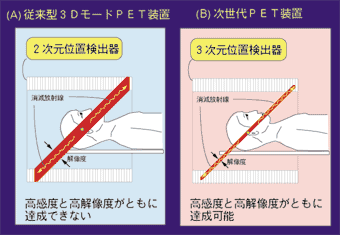NIRS NEWS No.44, JUN 2000
Development of the Next Generation PET Scanner in NIRS
Hideo Murayama
This article introduces a new project of developing the next generation PET in cooperation with other institutes, universities, and corporations during from Apr. 2000 to Mar. 2005. The prototype scanner will be placed at the second floor of the newly constructed building in NIRS for medical imaging.
A 3D PET can achieve the sensitivity of 50 times larger than that of a conventional 2D PET. Figure 1 (B) shows the parallax error in 3D PET unless information of depth of interaction (DOI). We are proposing a new detector with four-layered scintillation crystals, and its possibility has already been demonstrated in a laboratory condition. This detector will make the best use of 3D PET sensitivity without loosing the spacial resolution.

Fig.1: Schematics of (A) conventional 3D PET, and (B) our "next generation PET". But for the DOI, the sensitivity and the spacial resolution are trade-off relationship. |
|---|
The project totally develops scintillator materials, light detectors, electronics, and software. The number of line of response (LOR) will be not less than one billion! Because a very high sensitivity increases the "dead-time", some system like the pupil of an eye may be required. Other correction and adjustment methods will also be investigated.

Fig.2: The member of the team and the goal of the project. NIRS is supervising univesities and ccorporations. |
|---|
To catch up with the frontiers, not only the national investigators but also academic professors and commercial engineers join forces with the project. Finally, the next generation PET will take a movie of in vivo molecular metabolism.